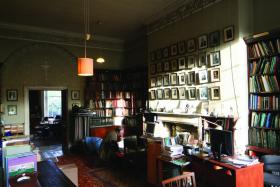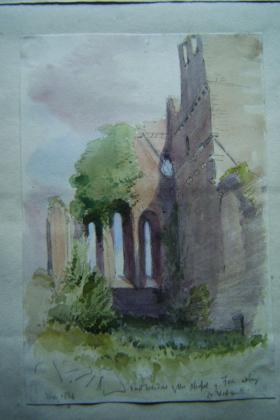The Royal Society of Antiquaries of Ireland
Published in 18th–19th - Century History, Issue 2 (Mar/Apr 2007), Issue 2 (Summer 1994), News, Reviews, Volume 15, Volume 2
A section of the Society’s library at 63 Merrion Square. (RSAI)
The year 1849 was a year of portents. Some, such as the reappearance of the potato blight in May or the record number of evictions (13,384), were harbingers of the suffering and social upheavals to come. Two events in that year, however, both of which took place in County Kilkenny, marked an equally noteworthy but altogether more hopeful beginning. At Callan, on 14 October, the first significant tenant protection society was formed, while some months earlier, on 2 February, four young men of mixed cultural and political affiliations formed the Kilkenny Archaeological Society (KAS)—later the Royal Society of Antiquaries of Ireland. Individually these groups helped to shape the course of the development of political and cultural life in Ireland for generations to come. The ‘mission statement’ of the KAS was to ‘preserve, examine and illustrate all ancient monuments and memorials of the arts, manners and customs of the past, as connected with the antiquities, language, literature and history of Ireland’. Nearly 160 years later that is still as urgent a task as it was in 1849.
The first half of the nineteenth century witnessed a growing interest in Irish antiquities and history. Among the most formidable influences on this was the introduction of the Ordnance Survey to Ireland in 1824. While not the primary function of the survey, its maps drew attention to local antiquities and facilitated organised visits. The suspension of the Parish Memoir after the publication of only one volume (Derry) may have been due not only to the cost and time involved but also to the interest in local monuments and accompanying national sentiment that the work provoked. This fascination with the ‘Celtic’ past coincided with the rise of the Young Ireland movement. The writings of George Petrie and Thomas Davis fostered awareness among the general public of a distinctive, ancient past. Davis exhorted people to ‘visit museums and antiquities’. Nevertheless, it was a time of increasing danger for the heritage of Ireland, as the Irish language suffered severe setbacks after the Famine of the 1840s and was vanishing from County Kilkenny even while the Society was establishing itself.
The two first, and highly dynamic, honorary general secretaries, Revd James Graves (1815–86) and John G. A. Prim (1821–75), a newspaperman, were responsible for the Society’s establishment and initial success. These cousins had a deep interest in Kilkenny—Graves had been making sketches of the ancient monasteries of the vicinity since his student days in Trinity College in the 1830s, while Prim had found time, despite his hectic schedule at the Kilkenny Moderator, to start collecting Irish ballads and transcribing from medieval manuscripts as early as 1841. Their knowledge of local antiquities was matched by the idealism of the organisation itself, which was non-sectarian and non-political. Its founding members included the Catholic Robert Cane, later mayor of Kilkenny, who was jailed as a Young Ireland organiser, as well as Philip Moore, a

East window of the chapel, Fore Abbey, Co. Westmeath, by George Du Noyer—among the Society’s outstanding collection of archives, photographs and drawings. (RSAI)
Catholic priest who was a close friend of Prim’s, and Dean Vignoles, a Protestant clergyman, of Clonmacnoise. Its subscription rate, at five shillings a year, was very modest in comparison with most English archaeological societies, many of which had high rates to ensure a socially exclusive and often aristocratic membership. The first journal of the Society was published in May 1850; it is now in its 134th volume.
From the start the Society was active in the protection and consideration of monuments. Members were expected to provide detailed reports about remains close to Kilkenny and to carry out local investigations in their own areas. Bridge construction sites and drainage works were examined and the location of mills noted. In 1850 the Society carried out its first excavation, at Glenfoyle rath near Castlecomer. In 1852 Graves and Prim conducted an excavation at Dunbell rath, which was being ‘levelled and trenched’. Items recovered from the excavations, which included objects of jet and bone, iron weapons and a fragment of a comb, were sent to the Irish Exhibition in London. In addition to excavations, the Society was interested in the accurate preparation of drawings of the ground-plans and sections of monuments.
The conservation of endangered buildings was a priority in the early days of the Society, and it was responsible for valuable work at sites such as Clonmacnoise, Co. Offaly, and Jerpoint Abbey, Co. Kilkenny. Other notable restoration and conservation projects included repairs to the fabric of buildings such as St Francis’s Abbey, Kilkenny, at Glendalough, Co. Wicklow, and at Monasterboice, Co. Louth. The Society also paid £8 for the purchase of the Banagher Cross and erected it at Clonmacnoise; this now stands in the National Museum.
At the second meeting of the Society, on 3 April 1849, it was decided to establish a museum, to be located in the Tholsel. The value of a museum lay not only in the protection of objects but also in the opportunity it afforded for comparison. The danger of travelling dealers and local jewellers who would melt down antiquities was realised; the important role of the Royal Irish Academy in saving many objects was appreciated by the members, but the Society hoped to be able to preserve objects of local interest. So numerous were the donations to the museum that the Society was forced to move three times in twenty years to accommodate the collection. In 1900, when the Society was already in Dublin, the museum collection was divided between the Kilkenny Museum, now at Rothe House, for items of local interest and the Royal Irish Academy for artefacts of national significance. This element now forms part of the collection of the National Museum of Ireland.
The Society also assumed a monitoring role, writing to complain in 1899 that excavations at Tara ‘ought not to be undertaken except under the supervision of competent archaeologists, and subject to their advice’. The Society successfully lobbied for the treasure trove legislation to be extended to Ireland. It also campaigned for Ireland to be included in the proposed national monuments legislation. When such legislation was passed in 1882, the Society declared it ‘defected’ since only prehistoric monuments were covered. It condemned the destruction of Dowth for road-building in 1879 (plus ça change!).
The Society moved to Dublin in the 1890s, and in 1917 purchased 63 Merrion Square. This is now the only remaining complete complex in Dublin of the classic form of Georgian townhouse. The house contains fine internal plasterwork, stucco, mantelpieces and door casings, while to the rear is an eighteenth-century-style garden with an intact mews complex (which has recently been restored by Irish Land Mark Trust) complete with original horseboxes. The Society is undertaking a series of major projects to conserve and secure the external and internal fabric of the house.
The Society’s library, which is available to members and external researchers, is located in 63 Merrion Square. In addition to all major Irish and foreign journals, the library houses the Society’s outstanding collection of archives, photographs and drawings. These include eighteenth-century minute and election books of the Corporation of Weavers, Corporation Books of Callan, Gowran and Thomastown, Co. Kilkenny, and antiquarian drawings by Du Noyer, Miller, Robertson, Graves and others. There is also an extensive photographic collection, as well as the Elrington Ball Dublin collection and the correspondence of Jonathan Swift.
In the ‘Bleak Days of ’47’ it would have been hard for those enthusiastic young men—fired with a zeal to preserve, examine and illustrate the heritage, culture and language disappearing before their eyes—to predict the breadth and scope of their success. Any one of the Society’s achievements—the conservation of Jerpoint, the preservation of the Du Noyer drawings, the establishment of the basis of a national museum, the fostering of local archaeological research and the insistence on ‘best practice’ in relation to the national heritage—would have been a noteworthy contribution to their country. Perhaps the greatest achievement is that, 160 years after that February meeting, the Society is a vibrant, growing, concerned and active organisation with a much-visited website and well-attended and lively lectures, talks, outings and excursions. The Journal is a volume of international record, and the house is being lovingly and painstakingly conserved.
Linda Doran is joint Honorary General Secretary of the Royal Society of Antiquaries of Ireland.
















